Fife Pictorial & Historical: Vol. II, A H Millar, 1895
pages 279 - 297
PARISH OF FORGAN
FORGAN is a Tayside parish, bounded on the east by Ferry-Port-on-Craig, on the south by Leuchars and Logie, on the west by Kilmany and Balmerino, and on the north by the river Tay. Its greatest length from east to west is five and one-eighth miles, and its breadth varies from one mile and a third to three miles. The coast-line is irregular, forming towards the east a succession of low-lying tracts of land, and rising in precipitous and rocky cliffs at the western boundary near Wormit, where is the eastmost termination of the Ochils. The parish generally exhibits the characteristic features of the scenery of North Fife - undulating hills and verdant valleys, rising by gentle slopes to a considerable altitude, but never reaching a height that could be termed mountainous. The highest points are at Newton Hill, in the south-west corner of the parish, 400 feet, and at Northfield, Inverdovat, St Fort, and Wormit, which average about 300 feet above the sea level. There is thus a succession of eminences forming a diminutive mountain chain, which forms a vast crescent, the points of which are at the shore at Northfield on one side, and at the cliffs of Wormit on the other. The rapid development of Newport has had the effect of greatly increasing the population of the parish within the last fifty years, as in that time the number of inhabitants has been more than trebled. The returns are as follows: (1801) 916 ; (1811) 898 ; (1821) 937 ; (1831) 1090 ; (1851) 1125 ; (1861) 1326 ; (1871) 2243 ; (1881) 3308 ; (1891) 3706.
The two principal estates in Forgan parish are Inverdovat, now called Tayfield, and Sandfurd, curiously altered since this century began into 'St Fort'. It appears that in early times the proprietors of Naughton (now comprehended in the adjoining parish of Balmerino), exercised the rights of superiority over the greater part of Forgan, and the latter parish was sometimes designated Naughton. This subject is treated in detail by Dr Campbell in his valuable work entitled Balmerino and its Abbey. In the twelfth century Naughton belonged to a family of Norman descent called De Lascels, and from the register of the Priory of St Andrews it appears that Alan, son of Walter de Lascels, granted a portion of his lands 'in the parish of Naughton' to the Priory circa 1188. Previous to this time, however, the church of Forgan had been conferred on the Priory by David I (1124-1153), and the gift was confirmed by Malcolm IV, William the Lion, and Alexander II. By the charter given by Alan de Lascels, son of the Alan already mentioned, the church of Forgan is described as 'the mother church of his estate of Naughton', whilst reference is made to 'the chapel of Naughton adjacent to the said church' Dr Campbell suggests that the lands of Naughton had belonged to the Crown when David I gave the church of Forgan to the Priory, and that subsequently, when William the Lion gave the estate to the Lascels family, the previous grants to the Priory were confirmed. As the church of Forgan was dedicated to St Fillan, the parish was occasionally designated St Fillans.
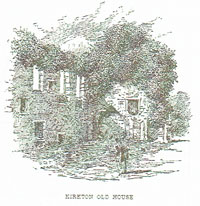
The old kirk of Forgan, which is now in ruins, is in a sequestered spot on the border of the division between the parishes of Forgan and Leuchars, about two and a half miles southeast from Newport. It presents no architectural features of special interest, nor is there anything in its construction to show the date of its erection, though the simplicity of its form suggests that it belonged to an early period, probably the beginning of the fourteenth century. It has been originally a simple oblong, measuring 67 feet 4 inches by 19 feet 5 inches inside, and divided into a nave and chancel. The western door is close beside the north wall, and another door had formerly existed near the west end of the south wall, but which has been blocked up long ago. Another door in the south wall near the east end gave access to the chancel. At a period long subsequent to the original erection a transept has been built projecting from the north wall, measuring 17 feet 5 inches by 16 feet 2 inches, and separated from the church by a graceful arch, with simple moulding. This place was used as the parish church until 1841, when it was found convenient to build a new church nearer the centre of the parish and adjacent to the main road from Newport to Leuchars. The graveyard at the old kirk of Forgan contains the burying places of the Berrys of Tayfield, the Stewarts of St Fort, and the Gillespies of Kirkton.
Among the natural curiosities in the locality are the famous yew trees near the old house of Kirkton, a little to the east of the ruined kirk of Forgan. These trees are five in number, planted to form the points of a cross, and are in full vigour and vegetation. Of the two largest, the one has a girth of 12 feet 7 inches at six feet from the ground, and a total height of 60 feet, the longest branch extending to 34 feet 6 inches. The other has a girth of 11 feet 3 inches, and a solid stem of 18 feet below the branches. Near them grows a large walnut tree, said to be the finest in Fife, having a girth of 12 feet, a stem of 16 feet, and a height of between 60 and 70 feet (Neish's History of Newport, page 71). The old mansion of Kirkton, which has long been in possession of the Gillespie family, is now in ruins, the principal seat of the Gillespies being at Mountquhanie, in the parish of Kilmany.
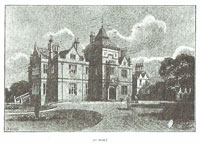
The estate of St Fort (or, as it was anciently designated, Sandfurd) was of much greater extent in olden times than it is now. Some confusion has arisen in the tracing of the history of various families connected with the estate in consequence of the dividing of Sandfurd into different portions possessed by separate proprietors. The superiority of the land belonged to the Kinnairds of Naughton, but the oldest family adopting the designation 'of Sandfurd' was that of Nairne, who held a part of the estate in the middle of the fifteenth century. The name of Alexander Nairne of Sandfurd appears in charters dated 1445-52, at which time he was Keeper of the Rolls. In 1499 David Nairne signed a charter 'at Sandfurd,' thus implying that he resided in a mansion on the estate. Alexander Nairne of Sandfurd was sheriff-depute of Fife in 1531-42, and the estate remained in the possession of the Nairnes till 1720, when Margaret Nairne or Pilmor, the heiress of the last Nairne of Sandfurd, sold this property. During last century it was held by the Duncans of Sandfurd, and was acquired about one hundred years ago by Captain Robert Stewart, HEICS. The latter gentleman was descended from the Stewarts of Urrard, Perthshire, who were lineal representatives of Alexander Stewart, Lord of Badenoch, fourth son of Robert II. Captain Stewart acquired a fortune in India, and on his return to this country he purchased the estates of Castle Stewart, in Wigtownshire, and St Fort, in Fife. The former estate was sold soon afterwards, and Captain Stewart fixed his residence at St Fort, demolishing the old mansion, and erecting the present splendid edifice. He was succeeded by his eldest son, Archibald Campbell Stewart, who died unmarried. The succession then fell to the second son, the late Henry Stewart, who was born in 1796, and died in 1871. His grand-daughter, Caroline Douglas Stewart, only child of Captain J. A. Stewart, is the present proprietrix of St Fort. She was married in 1888 to Captain (now Sir Walter) Corbet, eldest son of Sir Vincent Corbet, Bart., of Moreton, Co. Salop.
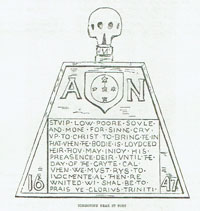
There is a curious tombstone in the corner of a field near St Fort, which bears the arms of the Nairnes of Sandfurd, with the initials A. N. and the date 1647. It has been suggested that this stone marks the burial place of Alexander Nairne, fiar of Sandfurd, who was killed in a London street during a tumult in 1642, the date on the stone marking the time of its erection. The Nairnes of Sandfurd are now represented in the female line by William Berry, Esq. of Tayfield. It is interesting to notice how the old name of this estate became gradually corrupted into its present form. Up till 1656 the spelling of the name was Sandfurd; but in the retour of Alexander Nairne, dated 11th January 1670, it appears as 'Sanctfuirt'. When Alexander Walker of Newton acquired part of the barony of Sandfurd lying nearest to Newton, circa 1660, his portion was called St Fort, and this designation still survives, although there never was any Saint of the name in the Scottish Kalendar.
Another family long connected with this estate was that of Walker of St Fort. Alexander Walker, the representative of an old Fifeshire family, acquired the barony of Newton, in the parish of Forgan, from Sir John Leslie, son of the Earl of Rothes, about 1650; and shortly afterwards he purchased one of the portions of Sandfurd, which had been known as Sandfurd-Hay from the fact that it had belonged at an early period to the Hays of Naughton, but was afterwards called St-Fort-Walker. The Walkers held this estate until near the close of last century, when Mr Stewart acquired it along with other portions of the old barony. It is impossible to identify accurately the different parts of these estates of Sandfurd, as frequent changes were made in the boundaries by successive purchasers. Newton is now the property of the Earl of Zetland.
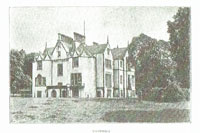
Tayfield, the estate upon which the greater portion of Newport has been built, is the seat of William Berry, Esq. of Tayfield. It formed part of the old barony of Inverdovat, an estate which was divided amongst several of the principal proprietors in the parish - the Hays, the Nairnes, and the Walkers - and was at an early date in the possession of a branch of the Leightons of Ullishaven (now called Usan), in Forfarshire. In consequence of this frequent change of owners it is very difficult to trace the proprietary history of the barony. It is certain, however, that in 1451 Alan de Kinnaird disponed a large part of the barony to Magister Gilbert Forstare, archdeacon of Brechin, so that the superiority had then been vested in the proprietor of Naughton. In the succeeding century the family of Lessellis of Inverdovat held part of the barony, whilst another portion, called 'Lichtounis landis', was the property of John Lyndsay of Balcarres, Lord Menmuir of Session. In 1615 James Elphingstoun was retoured as heir of his father, Frederick Elphingstoun of Inverdovat, and the estate then included the 'milns commonly called the Seymylnes'. After passing through various hands, the greater part of Inverdovat was purchased towards the close of last century by Mr John Berry, who erected the existing mansion overlooking Newport, and changed the name to Tayfield. His grandson, the late Mr John Berry, the third of the Berrys of Tayfield, died at Nice on 17th December 1877, and his body was brought home and buried in the family sepulchre at Forgan churchyard. His son is the present proprietor.
Wormit was part of the barony of Naughton until Alexander Crichton alienated 'the lands and fishings of Byrehills, Kirkhills, Cathills, Wormet, and the superiority of a portion of Inverdovat' to David Balfour of Balledmonth in 1594. The property passed through several hands, and was at length acquired by David Scrymgeour, advocate, in 1740. He was descended from the Scrymgeours of Kirkton, near Dundee, and from the Wedderburns of Kingennie. The present proprietor of Wormit is Henry Scrymgeour Wedderburn, Esq. of Birkhill, whose genealogy is detailed in the article on Balmerino parish. Wormit was a mere village with only a few houses until the North British Railway Company established a station here on the line to Tayport in 1889, and many large villas have since been erected in the locality.
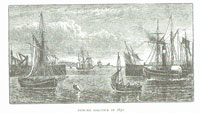
Newport took its rise from the ancient ferry betwixt Fifeshire and Dundee, which existed at this place at a very early time. References are found in documents of the twelfth and thirteenth centuries to four principal ferries on the Tay - one at Port-on-Craig, another at Seamylnes, a third at Woodhaven, a fourth at Balmerino. These were all regarded as connected with various estates in the neighbourhood, and were reckoned an important source of revenue. The ferry at Port-on-Craig was claimed by the Lords Gray when they held Broughty Castle; the passage at Seamylnes (near the site of the present Newport pier) belonged to the estate of Naughton; the Woodhaven ferry was claimed as part of the barony of Sandfurd; and the ferry at Balmerino belonged to the Abbey. The most valuable of these was that of Seamylnes, as the passage was more navigable there, and the connection with Dundee more immediate. It is almost certain that the chapel of St Thomas of Seamylnes was built by one of the Lascelles, lairds of Naughton, close beside the ferry, though no trace of the building now remains. The earliest documentary evidence extant of a proprietary interest in the Tay ferries is found in a charter confirmed 14th February 1481, whereby Alan Kynnaird of that Ilk, and laird of the one-half of the barony of Naughton, granted to John Adamson, burgess of Dundee, 'the one-half part of his common passage-boat from the harbour between the Seamylnes upon Tay and the Burgh of Dundee'. The system of letting the ferries to tacksmen led to a method of extortion and oppression which was contrary to the common weal ; and ultimately in 1551 an Act of Parliament was passed regulating the fares to be uplifted at the ferry of Dundee. A few years later the Provost and Bailies of Dundee were appointed keepers of the havens and common passages on the river Tay, but their power was limited to the shore, and they had no control over the ferry boats. It is probable that the Dundee officials had endeavoured to interfere with the proprietor of the ferry at Seamylnes, for in 1606 Patrick Kynnaird of that Ilk obtained an Act of Parliament to enable him to accuse before the Privy Council any persons who should hinder him from landing passengers at St Nicholas Craig, Dundee. In course of time it was found necessary to place this ferry under municipal control, and in October 1639, an Act was passed appointing Durham of Grange, Graham of Fintry, the Constable of Dundee, and the Magistrates of that burgh, together with several Fifeshire lairds, ' to sie thair be good boattis sufficientlie providet and sett down order thereanent both for Dundee and Broughtie'. Two years later the control over the ferries was confirmed by a commission, granted by the Duke of Lennox, appointing the Provost and Bailies of Dundee as admirals-depute of the Tay, and giving them power over the boatmen and ferries on both sides of the water of Tay.

The attention of the Magistrates of Dundee had been specially directed to the want of proper accommodation on the south side of the river for passengers by the ferry, and in 1713 the Guildry of Dundee decided to purchase three and a half acres of land from the laird of Inverdovat, and two and a half acres from the laird of St Fort, for the purpose of constructing a harbour to be called Newport, Dundee. Voluntary contributions to assist in defraying the expense thus incurred were uplifted in Dundee and in the principal Scottish burghs, and arrangements were made to have a harbour with piers and granaries constructed on the land acquired, and to have the highway from Kirkcaldy to the ferry put in proper order. The exact cost of the works at Newport cannot be ascertained, as the accounts were not regularly kept, but it is evident that the expense had greatly exceeded the anticipations of the Guildry. It had been expected that the new road and the improved ferry would bring a constant stream of traffic to Dundee, and that an important village would soon be erected at the Seamylnes; but the Guildry were too sanguine in their expectations. They could not at first get any tenant to take a long lease of the ferry, and were compelled to let it to a tacksman for an annual rent. The piers had been imperfectly constructed, for before 1717 large sums had to be spent in repairing them. The rent paid was £20 per year, and frequently this did not cover the expenses of upkeep. Convinced that the speculation was a failure, the Guildry offered the property for sale in 1749, but failed to find a purchaser. Previous to 1761 ex-Provost David Maxwell of Bogmyln had become bound to acquire the property, but he failed either to pay the price or take possession of it. Twenty years after this time (1782) Maxwell's trustees received the sum of £340 as payment of a portion of Newport acquired from them by a purchaser, and this sum was handed over to the Guildry of Dundee as part payment of Maxwell's debt. At this time an arrangement was come to whereby the lands at Newport were put up to public roup; and the then proprietors of St Fort and Inverdovat bought back the separate portions of these two estates. The construction of a new turnpike road, connecting Newport with the road from Cupar to Woodhaven, had the effect of making the ferry at Newport more available for traffic to Dundee than the ferry at Woodhaven, and thus ultimately settled the site of the new village of Newport.
As the ferries increased in importance the Town Council of Dundee took a firmer control over them. Up till 1820 the passage boats consisted of pinnaces, yawls, and small boats, and these were managed for the most part by seamen, who were, as a rule, proprietors of the craft that plied for hire. The supervision of the ferries, however, was not so strict as it should have been, as boats were often suffered to leave the shore overcrowded with passengers, and without sufficient crews to navigate the vessels. At length a melancholy accident occurred on 28th May 1815, whereby one of these boats was upset, nineteen persons being drowned; and it was made apparent that some effective method of regulating the traffic should be adopted. In 1819 an Act of Parliament was passed appointing trustees for the management and regulation of the ferries, and the sum of £20,000 was subscribed towards the cost of providing suitable boats, by contributions obtained in Fifeshire and Forfarshire. While the Bill that became the Act of 1819 was under discussion the idea of using steamboats at the ferries was first suggested, and after careful inquiries, the trustees decided to place a twin steam vessel on the route. In 1821 the twin steamship called the Union was employed on the passage, and powers were obtained from Parliament for the erection of additional works at Newport for her accommodation. By the new Act the trustees were empowered to build a pier to the west of the former one, and to construct roads leading to the east and west, according to designs prepared by Mr Telford, the eminent civil engineer. The foundation stone of the new pier was laid with masonic honours on 10th September 1823. A second twin steamer called the George IV was put on the service at this time, and was the first steamer fitted with the reversing gear devised by James Carmichael of Dundee. The Act of 1822 enabled the trustees to borrow money to carry out the works, and they obtained £18,000 from the Public Works Loan Commissioners, and smaller sums from the Dundee Banking Company and private individuals. As the Act was only current for twenty years, it was necessary to have it renewed in 1843; but as the interest on loans had fallen in arrears, the Public Works Loan Commissioners took over the ferries in August 1842, and when the new Act was passed the Commissioners were in possession. Shortly after this time attempts were made by the Edinburgh and Northern Railway Company to obtain control of the Newport ferry, as they wished to extend their line from Tayport in this direction, but the negotiations fell through because the Railway Company refused to pay the sum advanced by the Commissioners. Meanwhile the Scottish Central Railway Company, having purchased some of the other claims, discharged the claim of the Commissioners, and obtained full possession of the ferries. The Scottish Central Railway Company (afterwards amalgamated with the Caledonian Railway Company) intended to carry a line from Stirling to Newport, and to complete the connection with Dundee by means of the Newport ferry. The business of the ferry was conducted by the Railway Company up till 1873, when an Act was obtained whereby the control of the Tay ferries was vested in the Dundee Harbour Trustees, the Caledonian Railway Company receiving £20,000 as purchase money. The development of the railway system, and the connection of Dundee and Newport by means of the Tay Bridge, has to a large extent superseded the ferry, although it is still maintained under the charge of the Dundee Harbour Trustees.
The history of the two bridges that were erected to span the Tay is a most interesting one. The project of connecting Fife and Forfarshire was looked upon from the first as a national affair, and the disaster which befell the first bridge awakened interest throughout the world. It will be useful, therefore, to give a consecutive history of these structures, so that the details may be thoroughly understood.
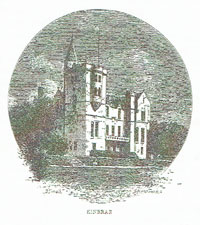
The improved facilities for communication between Dundee and Newport had the effect of expediting the feuing at the latter place. In 1870 many large villas were erected on the hill overlooking the Tay. One of the most notable of these is Kinbrae, a Scottish baronial mansion, completed in 1872 from designs by the late Mr Heiton, of Perth, for Sir John Leng, MP for Dundee. Sir John is the son of the late Mr Adam Leng, of Hull, and was born in that city in 1828. He was educated at the Hull Grammar School, and in 1847, when only nineteen years of age, he was appointed subeditor of the Hull Advertiser, and thereafter devoted himself to journalism. In 1851 he went to Dundee as editor and general manager of the Dundee Advertiser, a newspaper which had been founded in 1801, but which had then a very limited biweekly circulation. With characteristic energy, Sir John set vigorously to work to improve the paper, and it soon became a power of considerable magnitude, both locally and throughout the country. After the removal of the stamp and paper duties the Advertiser was transformed into a daily journal. The People's Journal was established by Sir John in 1858, and soon attained a very large circulation ; and in 1877 he founded the Evening Telegraph, a daily paper issued in several editions, and circulated largely over an extensive area. Sir John also originated in 1869 the People's Friend, a weekly literary journal which has a very wide circulation. When a vacancy occurred in the Parliamentary representation of Dundee through the death of Mr Firth in September 1889, Sir John Leng was returned as member for the city without opposition; and at the general election of 1892 he was placed at the head of the poll, and thus became senior member for Dundee. On 1st June 1893, he received the honour of knighthood. Besides his journalistic work, Sir John has published a volume entitled Impressions of America (1876), and numerous pamphlets on political and social subjects. About the same time as Kinbrae was erected the adjoining villa of Westwood was built for the late Mr Harry Walker, Dundee, and also the villa of Balmore for William Robertson, Esq., ex-provost of Dundee. Nearly two miles from Newport, on the road to Tayport, the villa called The Cliffe is situated. The place was for a very considerable time in the possession of the family of the Powries of Reswallie, in Forfarshire, but has now passed to their kinsman, Lieutenant Colonel James Powrie Soote, late of the 14th Prince of Wales Own Regiment, who is a nephew of the present laird of Reswallie. After many years of active duty, including service during the New Zealand War of 1866, Lieutenant Colonel Soote left the army and settled here.
A large portion of the estate of Tayfield has been feued to form the town of Newport, and that place has risen very rapidly. Streets, terraces of houses, and villas now occupy the spots that were fields under cultivation early in this century. In 1841 the population numbered only 260; in 1871 it had risen to 1507; in 1881 it was 2311; and in 1891 it had reached 2548. It was constituted a police burgh in 1887 by the adoption of the Lindsay Act, and is governed by a Provost and Commissioners. The Established Church was built as a chapel of ease in 1871, and Newport was constituted a quoad sacra parish in 1878. There are also in the burgh a Free Church, erected in 1868 on the site of an earlier structure, a United Presbyterian Church, built in 1881, a Congregational Church, in 1868, and an Episcopal Chapel, in 1886. The Blyth Memorial Hall was erected in 1876 by Mrs Blyth-Martin, in memory of her three brothers, at a total cost of £7000, and presented to the burgh as a suitable building for holding public meetings. The harbour was constructed from designs by Mr Telford, and was specially contrived to afford accommodation for the steam ferry betwixt Newport and Dundee. The burgh has so greatly extended along the course of the Tay that there are two stations on the railway between Tayport and Wormit, named respectively East and West Newport.
Return to: Library Contents
